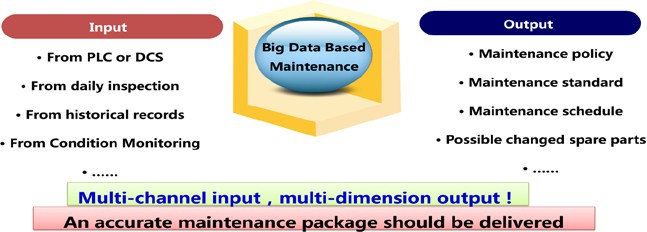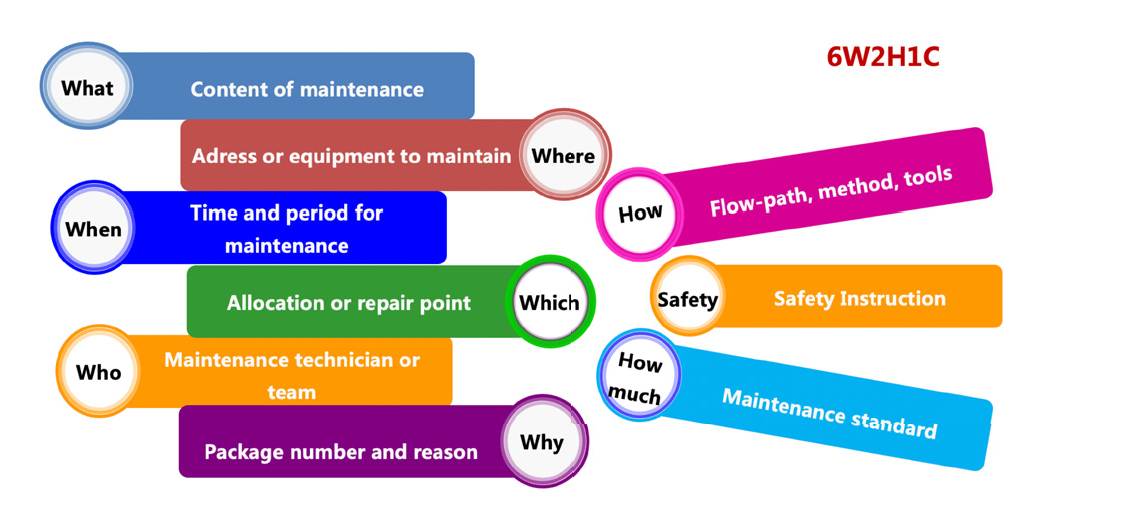Li Baowen1
International Cooperation & Exchange Center of the CAPE,China ,shflibaowen@163.com,
Xu Baoqiang2 , Guangzhou University,China shfxubaoqiang@gmail.com,

Abstract #
We raised 12 different directions on smart maintenance, which including smart maintenance strategy generation. In current days , the data will play more and more important role in decision making for maintenance strategy.
In this paper, the author describes the concept of Big Data Based Maintenance, i.e. BDBM. The input data of the system is from four sources:
The process control system, DCS or PLC, such as temperature, speed, pressure, etc.; The additive condition monitoring system, such as vibration, infrared monitoring result; The inspecting discoveries from shop-floor operators;
The historical records of the equipment.
From above mentioned data and historical failure records, the system will find the feature values. Each value is given a trap range, while the current operation value falls into the trap, the system will issue an early-warning, and generate an accurate maintenance package, which includes 6W,2H and 1S, i.e., What,maintenance content, When, time point, Where, which equipment, Which, the component, the part of equipment, Who, the maintenance technician, Why, the reason, the evidence, How, the flow chart, tools, methodology of maintenance, How Much, the standard of maintenance, and Safety, the safety instruction of maintenance.
The system should self-leaning from the reality, and approach the accurate decision making inch by inch.
The authors begin to apply the system in subway transportation, power plant, and further practice should be continuing.
Anyway, the author predict that, BDBM will be the main trend of future smart maintenance. KEYWORDS: Big data, Smart maintenance, Accurate maintenance
Introduction #
Around 5 years ago, we raised 12 issues of smart maintenance, such as Intelligent inspection and monitoring, Intelligent lubrication, Intelligent information processing, Intelligent failure diagnosing, Intelligent spare part managing, Intelligent strategy generation, Intelligent knowledge managing, Intelligent repair instruction—IETM, Intelligent training, web safety intelligent managing, Intelligent MRO managing, as well as Maintenance Robot. Fig. 1 shows the 12 issues of smart maintenance.
Among maintenance strategy, the important trend should be “ The Big Data Based Maintenance—BDBM”. Not because we are in the Time of Big Data, just because of the technological development of equipment.
In some plant, many engineers reflect that, it is not easy to persuade the higher leader to invest condition monitoring instruments. However, some data in the control system such as DCS or PLC reflects the degradation indirectly, but not be used. Another useful data is the historical records related to maintenance, spare parts changing, and failures happened which will help to predict and relocate new failures; The third issue of data comes from the operator’s daily inspection by human organs or PDA; If the aforementioned data are not enough to predict or locate the failure, then the last issue of data—condition monitoring measure should be introduced. Hence, the last and the most expensive method should be adapted under the Lean Environment.

Fig.1 12 issues of smart maintenance
Through data collection and integration, and failure diagnosis, the outcomes should be maintenance schedule, content and spare part changing information, which we call maintenance package. The general framework is shown by Fig. 2.

Fig. 2 The general framework of BDBM
The Category of BDBM #
In fact, not all equipment is suitable for BDBM. If the consequence is not serious with small economic lost, zero accident, no environmental damage, no quality damage, no health affect and no obvious chain damage for the plant, then breakdown maintenance (BM) is the most economical strategy. If the plant or part of the equipment has an obvious exhausting interval, the regulation is handled by us, and other parts will run normally within this period, then time based maintenance (TBM) is the best strategy. There also be no available monitoring measure of the failure diagnosis for some equipment. So, BDBM is only suitable for the remaining equipment.
Before BDBM, the risk analysis is necessary to focus to the high risk area and plant. The main structure of risk analysis is shown by Fig. 3.

Fig. 3 The main structure of risk analysis
The Significant of risk analysis is as follows,
Let higher leader focus to High Risk Area or Equipment ,
Reinforce the investment to the high risk area or equipment; BDBM will first choose the High Risk Area or System to test;
Risk is a dynamic concept, changing with different loading time, different age of the equipment. So, reviewing and drawing a Risk Map every half year is necessary.
The Logic Process of BDBM #
The main logic of BDBM is as follows,
Determine the high risk equipment,
Extract the Feature Value according to different failure mode of equipment ;
Design the feature value trap threshold X-day, Y-day and Z-day before the breakdown occurs based on historical failure process ;
Monitoring the feature value continuously or with high frequency;
Lower than 50% Feature Values drop in the “trap”, then a light warning start, and a predictive period is given;
Exact 50% Feature Values drop in the “trap”, then a middle warning start, and a predictive period is given; All Feature Values drop in the “trap”, then a strong warning start, and a predictive period is given;
A maintenance decision is made and a maintenance package is generated. Fig. 4 shows the main logic flow of BDBM.

Fig. 4 the main logic flow of BDBM
BDBM—Case Simulation #
We design 3 thresholds on the curve before 30, 15 and 7 days as traps to monitor the future status of equipment as is shown in Fig. 5.,
During the process of monitoring, we discover“Flow”get into Tr30-1, then the light warning is started, and “the failure will happen within 30 days” is predicted. While 3 feature value all get into traps, then the strong warning is started, and “the failure will happen within 7 days”, and the maintenance package is generated.
Just like the maintenance of aircraft, an accurate maintenance package should be generated as is shown in Fig. 6

Fig. 5. The case simulation of feature value monitoring and trap threshold design
Concerning the outcomes of BDBM, three optional maintenance modes of dynamic maintenance package can be chosen according to the reality which is shown as Fig.7.
When we chose the restoration maintenance mode, although the performance will be restored, but the frequency of maintenance will not be reduced, may be increased because of the degradation of the equipment. When we chose part replace maintenance mode, the performance will be restored regularly, the frequency of maintenance should be keep a constant because of the function of new parts. When we chose the proactive or upgrading maintenance mode, then the performance should be increased and the frequency should be decreased too.

Fig. 6 Maintenance package generated with 6W, 2H and 1S

Fig.7 The different modes of maintenance and results
Self-learning is necessary to improve the BDBM continuously. The process of self-learning is shown as Fig. 8.

Fig. 8. process of self-learning
After the maintenance, if the reality prove that the prediction is correct, then the monitoring should be executed continuously. If the maintenance process discover that, the prediction is not correctly, then the feature we extract should be reviewed, we can change some new features to begin our new test. If the features we chose are not enough to reflect the failure, then we should add some new features to guarantee the prediction of failure. Some time the problem because of the range of trap threshold, then we can solve the problem by redesigning the threshold. Then go back to the beginning point again.







